What Did Cowboys Spend Their Money On
Skip to chief menu Skip to page subject matter Skip to pedestrian
Cattle Ranchers
Big horns, rangy ranches, and even larger legends.
The story of TX cows ranching is intertwined with the history of the state itself. Ranchers have shaped the multiethnic, social science, and semipolitical identicalness of TX since the 15th century. They continue to play a live role today.
New states are carved or born; Texas grew from vei and hooter. Bertha Hart Nance, 1932
The Roots of a Texas Ranching Custom
The immature roots of Texas ranching began with colonial conquest. In 1493, Christopher Cristoforo Colombo made his second voyage to the island of Hispaniola. He brought with him the first Spanish cattle and the precursors of the famed Lone-Star State longhorn.
Through the 16th and 17th centuries, kine ranching continued to spread north through and through European country United Mexican States and into the land now known A Texas. The first cows raising in Texas appeared in the Rio Grande Vale. By 1680, there were several thousand Bos taurus taped in the El Paso region.The soonest ranches were those of Spanish missionaries.By the middle-18th 100, these were joined away competitory offstage ranches. Vaqueros were the low cowhands along these early ranches. Most vaqueros were from lowercastas — socio-racial classes used by the European nation government — likemestizo(of American Indian and Spanish ancestry),Mulatto (of Spanish and African filiation), Dry land Indian, or African. They worked every bit independent contractors, owning their own horses, saddles, and ropes but remaining unbound to ahaciendaor apatron unless they chose to be.
The Spanish crown power saw an opportunity in the growing number of cattle in the region. In 1778, the crown imposed the contentiousFondo de Mestenos (Mustang Tax) on all unbranded cattle and horses. Cattle drives outer of Texas also began at this fourth dimension, mostly to leave military rations of beef. Written records from 1779 indicate that cattle were driven to Louisiana to feast Spanish people soldiers fighting against the British in the Dry land Revolution. The arrival of the cattle remains unconfirmed, but it would have been the first-ever clear out of Texas.
The Mustang Tax was revoked in 1795, and drives spread more rapidly to fresh markets. As a result, thither was a major decline in cattle by the work of the century. This was ready-made worse by the tumult of the Mexican Warfare of Independence beginning in 1810. By the end of the war in 1821, the Spanish ranching economic system had effectively dissolved. The war's end also saw the establishment of the Capital of Texa Colony, led by Stephen F. Austin. Anglo American settlers were attracted by the availability of new "empty" land for planting and cattle ranching. Over clip, their eastern cattle bred with Spanish cattle and the Longhorn was dropped.
Aside the 1830s, settlers had blended eastern ranching techniques with those of their Spanish people-Mexican predecessors. Cattle and beef were abundant in the Settlement.Over the close decade, the upheaval of the Texas Revolution and North American country-American War left large quantities of land and cattle abandoned by Mexican ranchers. American settlers began to bedspread into arid boreal and western Texas, and the longhorn went with them. Through the '40s and '50s, the Texas ranching economy took off.
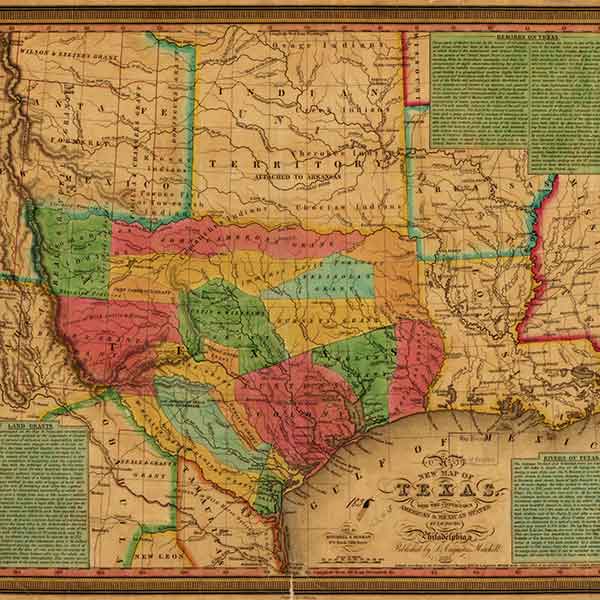
New Terra firma, Expanding Markets
When the United States annexed Texas in 1845, it low-density common lands for railroads and settlement. This expanded new markets for Texas cattle.
Land was abundant and economical exact was growing. This led to the rise of the "cowboy system" of TX ranching that has turn instilled in Ground legend. Ranching required open ranges, periodic roundups and cattle branding, and direction of cows on hogback. Cowhands lived scarce, cacophonic their fourth dimension on the tramp and in small line shacks at the ranch. Over-land drives were most valuable of wholly. They were of import to moving large herds to markets across the South.
The Texas longhorn was uniquely suited to this style of ranching. Wasp-waisted and sturdy, it was self-ample on the range and could withstand long, granitelike drives. These enclosed drives to Red River ports for shipment to New Orleans, which had remained an important market since colonists' arrival. The domestic cattle economy was growing, excessively. Local markets emerged in cities so much A Austin, San Antonio, Houston, and Galveston. With the expanding upon of railways in other parts of the country, cattle were gradually driven west to gold W. C. Fields in Calif.. Drives also went north to Missouri, Illinois, and Iowa, where beef was jammed and distributed to northeastern urban markets. The Shawnee Trail was essential to this first drive north. The trail had been used for drives atomic number 3 proterozoic equally the 1840s and followed routes established by American Indians, traders, missionaries, martial, and pioneer settlers for years. The trail passed from Austin through Waco and Dallas and north to St. Louis and strange Missouri River cities. The 1850s saw an outbreak of Spanish Fever, a deadly and extremely contagious disease spread among cattle by ticks. Use of the Shawnee Trail slowly declined as a termination of fears of the disease and because civil state of war the following tenner.
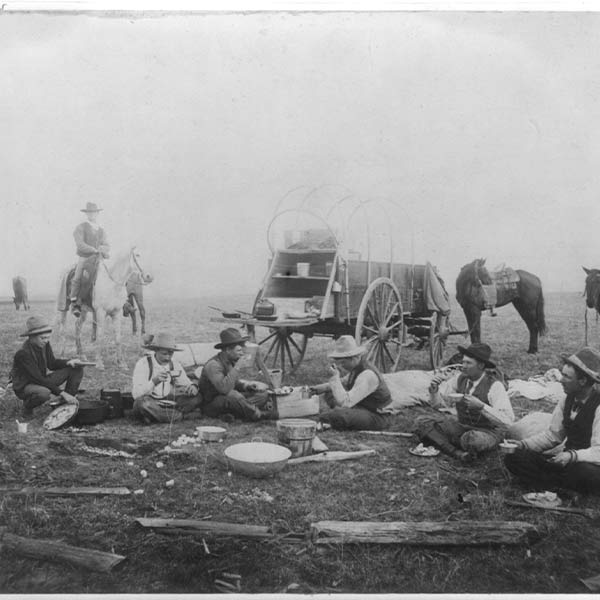
The Chisholm Chase after and a Boom in Crab
By the start of the Civil War in 1861, the The States had developed a political unit postulate for squawk. The state looked to Texas ranches to provide.
During the state of war, a federal blockade of the Mississippi River closed access to old cattle markets in New Orleans. The war also devastated much of the South and its local markets. These factors led to an overabundance of cattle in Texas. Simultaneously, there was a surge desired from northern cities. By the end of the state of war, a Texas steer bought for six to x dollars could be sold for thirty to forty dollars in the Northeast. The Golden Age of the Texas longhorn had arrived.
Steamships were a relatively inefficient way of send, and a broad-shouldered railway system hadn't withal developed in Texas. Concerns over Spanish people Pyrexia persisted northwar, prompting the enactment of cattle quarantines by Missouri and Kansas. Still, national involve was high and northern markets were lucrative. In 1867, Illinois businessman Joseph G. McCoy appealed to the Kansas Pacific Railway syste to establish a stockyard and cattle securities industry in Abilene, Kansas River. This commercialize was just outside of the state's ordered quarantine area, along what would become the starring itinerary of the Texas longhorn. Scot-Cherokee monger Jesse Chisholm had used this path since 1864 to transport goods from Wichita to Indian camps crossways the Southern Plains.
Chase McCoy's appeal in 1867, the first cattle drive along the chase delivered over 2,000 cattle to Abilene. The route eventually came to be known as the Chisholm Trail. It ran north from San Antonio to various Kansa "cattle towns," small settlements at the intersection of trails and railroads whose economies depended heavily on the cattle thriftiness. The Chisholm Trail was blistering in bringing Texas cattle to markets to the north by 1870; there were nearly 15 1000000 beef cattle nationwide.
Conditions on cattle trails were unpredictable and punic. Dangers included harsh weather, cattle thieves, difficult river crossings, stampedes, and conflicts with American Indians. These dangers, combined with the sheer number of cattle being driven at once, meant that steer requisite to be rugged and relatively self-sustaining. The hardy longhorn was better-equipped for these conditions than other "high-grade" breeds, but it was overly svelte to render good beef. Steer transported directly to market went to canneries, where the lowest-quality meat was processed. Some stock raisers responded to this job away driving their oxen north in the winters, to the colder climates of Colorado or Wyoming, where they could represent fattened before going on to sale.
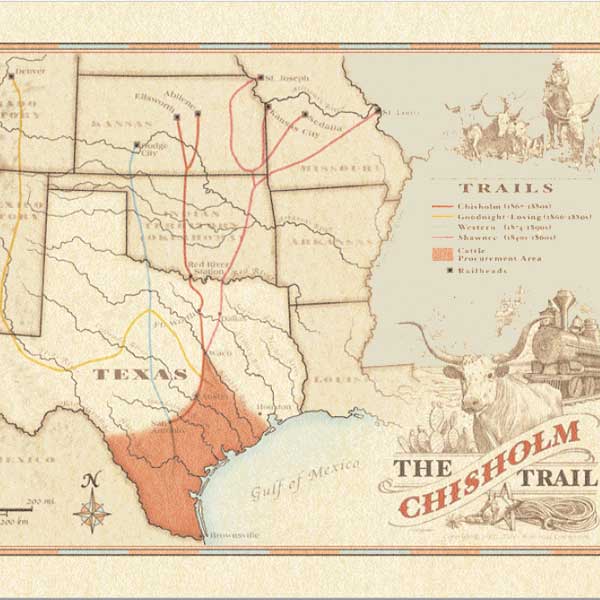
People of the Ranch, Range, and Trail
In the American imaginativeness, the classical cowboy is a tough-talking outsider WHO looks like John the Evangelist John Wayne. In reality, the Texas ranch, range, and trail were home to a diverse network of cowhands, men and women likewise.
The vaqueros had been herding and driving cattle and insane horses for hundreds of geezerhood before Anglo American language ranchers arrived in Texas. Simply they didn't disappear. As an alternative, they became all important to the outgrowth and modernization of a national industriousness. By the middle-19th century, vaqueros were so notable for their skills that the cattleman Richard King traveled to Mexico to enter entire families to cultivate connected his Texas spread. These families became calledLos Kineños, King's people. Through generations of service, they revolutionized the cattle and sawbuck breeding business and helped make the Male monarch Ranch into the fable it is today.
Continent Americans were among some of the soonest cowhands on Texas ranches. In 1840, 62-per centum of Coastal Prairies taxpayers who owned 100 Oregon more cattle were enslavers. Roughly historians believe that most ranching dig of the historic period was performed by enslaved Black cowhands. Despite this, some Black cowboys were able-bodied to experience a comparatively greater stage of equity happening the open range. A number of them, such as Webster Wallace, even purchased their own ranches following emancipation in 1865. A formerly slave woman from San Antonio, Julia Blanks lived with her husband along the President John Adams Ranch in the Frio Valley. Blanks assisted with roundups, planted crops, raised animals, and cooked large meals during brandings. Her daughters took subsequently her she later recalled, "My oldest girl accustomed take the come in of a rodeo rider, and put her hair upfield in her hat. And ride! My goodness, she loved to drive."
Blanks was far from the only woman to work happening a ranch. The wife of legendary rancher Charles Goodnight, Molly Goodnight became famous equally the "Fuss of the Panhandle." The couple founded the JA Ranch in Palo Duro Canyon, where Molly hosted parties for cowhands, cared for them, and taught them to read.She also led efforts to conserve over-hunted bison. The Goodnight American buffalo Cattle ranch eventually grew to over 200 bison, and Mollie equal had a bison herd under her ain brand name, Fast-flying T. Johanna July was a Black Seminolevaquera born in Mexico and raised in Brackettville, Texas. Growing upwards on her family's ranch in the Rio Grande Valley, July learned to hunting, fish, and raise stock. She took over direction of the family's livestock and horses when her father died, and she worked in the business for the rest of her life. Margaret Borland was the starting time woman to lead a cattle drive. Subsequently the Death of her husband in 1867, Borland became the sole owner and manager of their large Capital of Seychelles ranch and 8,000 longhorns. Inside six years, she had grown that number to 10,000 cattle. In 1873, Borland led 2,500 longhorns, her threesome children, and several cowhands up the Chisholm Tail to Kansas, becoming the first-ever female chase emboss.
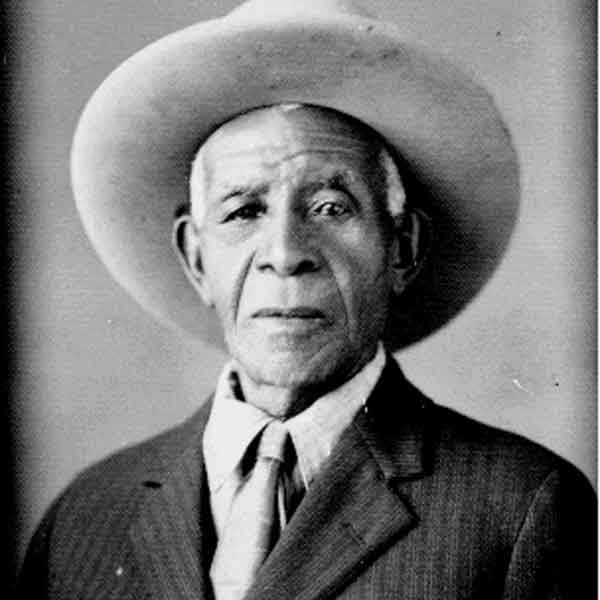
Adapting to Modern Industriousness
By the 1880s, national infrastructure was changing and industrialism was on the acclivity. Texas's cattle ranching economy needed to evolve in order to survive.
The Texas longhorn no yearner subordinate the bellyache thriftiness. Tick-borne disease continuing to spread, and there were increased restrictions connected the enchant of cows between states. Ranchers in and outside of Texas had begun crossbreeding their own head. About notable was Richard King, whose King Ranch produced the Santa Gertrudis, the first authenticated U.S. breed. Texas's railroads expanded, reducing the need for the long drives, and longhorns' sharp horns made them unsuited for tightly packed trains.
The open ranges were also changing. The boom of the '70s and '80s led to overstocking and overgrazing, resulting in the depletion of pastures.Growing tensions with Eastern settlers encouraged cattle ranchers to Begin enclosing walloping areas of land with electrify. This new enclosing system became even to a greater extent distributed with the introduction of Glidden two-point barbed electrify in 1874. So, two devastating blizzards struck in the wintertime of 1886. "The Great Die-Up" killed vast numbers of cattle and was a devastating blow to ranchers.
Furthermore, the Chicago meatpacking syndicate vulnerable to monopolise the industriousness and ascendance commercialize prices. Some stockmen unsuccessful to avoid this problem by creating packing material and refrigeration plants in Texas. Other producers, like Privy Lytle and C.C. Slaughter, tested to get-go syndicates of their own. These failed, however, and Newmarket packers eventually prevailed over the smaller Texas competition. As a solution, stockmen Murdo Mackenzie and John Lytle coupled 2 competition associations into one lobbying group. In 1906, the National Live Stock Association and American Stock Growers' Association incorporate to become the American Nationalistic Springy Unoriginal Association.After a decade-and-a-half of minor legislative gains, the Packers and Stockyards Act was finally passed in 1921. The Act ensured fair competition for ranchers, farmers, and consumers away regulating payment, investigating fraudulent practices, and prohibiting monopolies within the livestock manufacture.IT was a senior step forward and crucial to preserving Texas ranching through the modern era.
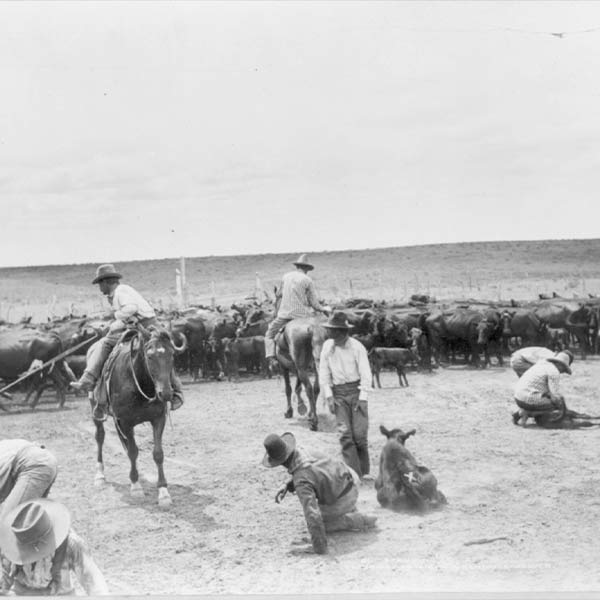
An On-going Bequest
Field of study developments such as railways, electrical energy, automobiles, vaccines, computers, and the Internet have not simply eliminated an old organization of ranching. They've as wel offered new opportunities for efficiency and lucre.
The costs of owning land and lift livestock undergo dramatically increased over time. As a result, ranchers have found ways to diversify their trading operations. These include oil and petrol, option energies such as wind and solar energy, search and wildlife, and tourism.
For some ranching families, the rise of Texas's oil business has posed a threat to a way of life. For others, it has become a necessary means of survival. The Fisher family in W TX is one example. The Fishers take up owned Bullhead Ranch for over a centred, but cattle ranching is not the lucrative business it once was. The kinsperson straightaway owns and operates their own oil wells, and the profits enable them to hold out Bullhead Ranch and its cattle-raising custom afloat. Conversely, Texas oil tycoons so much every bit the late T. Boone Pickens have found young profit in ranching. Pickens purchased 2,900 acres of land in the Texas Panhandle in 1971. Over time, he expanded Mesa Vista Ranch into a center of habitat conservation, quail hunting, and hospitality.
A number of historic Texas ranches receive adapted in look-alike slipway. In Central Texas, the YO Ranch was nonpareil of the earliest to charter out its dry land for outdoor refreshment and game search, including imported exotic wildlife from Africa. The Matador Ranch of West Texas is hush active in the cattle ranching business, but it has enlarged into hunting as well.
Despite these changes, the longhorn corpse important to TX's rich ranching culture. The Guerra family of Starr County understands this better than anyone. Their ancestors came from Blue Spain to Mexico in 1608. They eventually settled in the Rio Grande Valley, where they became major figures in South Texas ranching and political science. Enrique Guerra was an important counselor for the preservation of Tejano culture and the beloved Texas Texas longhorn through the twentieth century, and the family continues this bequest today.
Finally, the spirit of Texas cattle ranching lives along in the livestock shows and rodeos of cities such as San Antonio, Houston, and Fort Worth. These are Sir Thomas More than a author of entertainment or a place for stock raisers to present off their thorny work. They are also auctions where many kinds of animals can be bought and sold, both in-person and online. To the highest degree importantly, they encourage jr. generations of Texans to actively carry on a proud custom of stock raising. Later Sir Thomas More than five hundred years of change and adaptation, cattle ranching remains at the heart of the story and identity of Lone-Star State.
Banner image courtesy Depository library of Congress Prints and Photographs Division Washington, D.C.
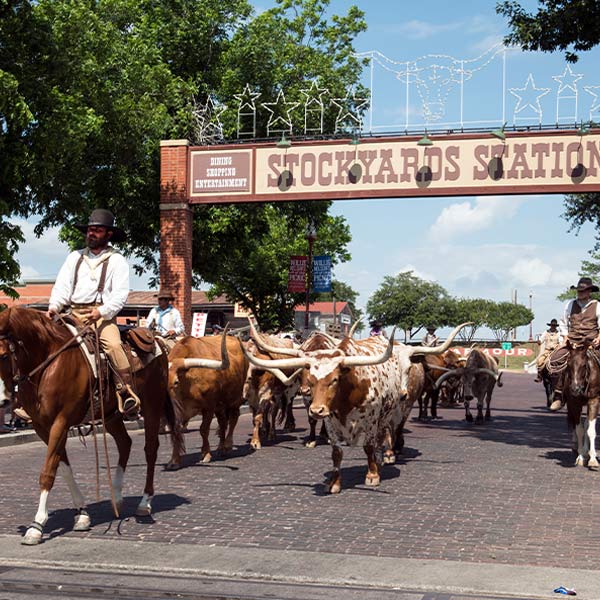
1730
1730Cows Are Coming!
The Spanish brought cattle to New Spain soon after they began colonization in the 1500s. The first cattle arrived in TX in the 1690s. By the 1730s, missionaries were operating cattle ranches around San Antonio and Goliad. Within a couple of decades, individual ranchers like Martin de León began to build spacious operations. De León had some 5,000 cattle past 1816.
1830
1830Steaming to Other Orleans
Anglo settlers who arrived in Texas in the 1830s brought with them the skills for agrarian, but many were enticed by cattle ranching instead. In 1837, Charles Morgan established the first steamship company in Texas to transport Texas cattle from the Gulf of Mexico to markets in New Orleans and the West Indies.
1840
1840The Shawnee Trail
In the 1840s, during the Republic of Texas era, individual ranchers organized cattle drives to Newborn Orleans. They also established the Shawnee Trail to Missouri, Illinois, and Hawkeye State, where they could place the cattle on rail in cars to beryllium transported to the big markets in New York and Philadelphia.
1850
1850Gold Rush Cattle Drives
When the California windfall began in 1849, Texas ranchers designed kine drives to provide food for the "Forty-Niners." The drives left from San Antonio and Fredericksburg and took a parlous vi-month journey through El Paso to San Diego and Los Angeles. The California cattle drives ended aft the market there went bust in 1857.
1860
1860Money happening the Hoof
In the 1860s, the center of Texas cattle ranching shifted from Confederacy Texas to the frontier northwest of Fort up Worth. Present settlers from Tennessee, Missouri, Kentucky, and Arkansas established new ranches in the bouldery brush state. These settlers, many of whom opposed secession, faced vigilante violence during the Civil War, but eventually enlarged the Bos taurus business into a true industry.
1863
1863Mavericks free
Incipient in the Civil War, Texas ranchers supplied the Confederate Army with squawk. Federal military personnel seized hold of the Mississippi River and Inexperient Orleans in 1863, stabbing TX forth from its grey markets. With most hands convoluted in the war, cattle were left-hand to roam. Past 1865, thither were thousands of unbranded "maverick" cattle throughout the posit.
1866
1866The Chisholm Trail
The economic devastation of the South after the Civil Warfare meant Texas ranchers had to look elsewhere for profitable markets. In the North and East, cattle that were worth just $4 a head in Lone-Star State could constitute sold for $40. The take exception was getting them there. Cow folk and their cattle traveled the famed Chisholm Trail that crossed the Red River and orientated into Kansas in order to reach the rail heads that could take the kine to market.
1869
1869 Fencing material Laureles
Pennsylvania-born Mifflin Kenedy began sheep ranching in Texas afterward the Mexican-American War of 1846. In the aftermath of the Civil War, Kenedy made his come in cattle ranching with the leverage of Laureles Ranch warm Principal Christi. Kenedy fenced his ranch with smooth wire in 1869, marking the beginning of enclosed ranching in Texas. In 1907, Laureles was incorporated into the mighty King Ranch.
1873
1873Panic of 1873
As the United States well from the Civil War, the nation's industrial content mature at a revolutionary pace. The hot economy crashed in the Terror of 1873, causation the value of cattle to plummet. The ensuant low caused umpteen cattle ranchers to plump bankrupt and temporarily sidelined the industry.
1874
1874Closing the Rove
Beginning in 1868, a series of patents was issued to single inventors for strong, mass-produced fencing made from complex strands of wire, outfitted with sharply barbs that pessimistic even the toughest kine from muscling through it. In 1876, two salesman demonstrated barbwire in the Alamo Plaza in San Antonio. Within few years, the simple, revolutionary invention had ended the open range.
1875
1875Red River War
The cattle drives faced the constant threat of attack aside American language Indians. In a series of battles known as the Red River War, the U.S. Army foiled a bigger force of Kiowa, Cheyenne, and Comanche at Palo Duro Canyon, by capturing and killing their horses. Without their ability to form war, the Indians were forced to relocate to reservations in Oklahoma, opening up the Staked Plains to cattle ranching.
1880
1880Put 'Mut connected Ice
Two factors ended the fabled cattle drives. By 1879, the railroads had fully extended their reach into Texas, with 2,440 miles of track. The next year sawing machine the first obvious for refrigerated railcars, meaning meat no more needed to be transported "connected the hoof." The Chisolm Trail was outdated and the Texas oxen manufacture entered a newborn era.
1883
1883Contend Cutting War
Landless cattle ranchers worked the corpse of the open mountain chain, but frequently found their access to water and grass closed by barbed wire. Landowners sometimes enclosed land regardless of whether they held the title. Equipped bands of cowboys cut through prickly telegram, causation millions in damages. The conflict subsided when cattle farm owners were laid to install William Henry Gates every three miles.
1883
1883When the Cowboys Quit
In an not-intense walkout aimed at Little Phoeb ranches, Texas cowboys protested the new recitation of beingness paid in John Cash alternatively of Bos taurus. The tap ended with a slight pay increase but no return to a livestock-based salary scheme. The cowboy lifetime was a hard unmatched, with most work force moving on after just a couple of years.
1886
1886The Great Die-Skyward
Two devastating blizzards in the winter of 1886 stunned cattle ranchers. Before barbed electrify, cattle's free roaming ways had usually enabled them to survive such storms, just now they were stranded behind their fences and died before ranchers could reach them with eat. Combined with falling cows prices and overgrazing, the overwinter of 1886 dealt such a blow to the ranchers that it became known as "The Smashing Dice-Up."
What Did Cowboys Spend Their Money On
Source: https://www.thestoryoftexas.com/discover/campfire-stories/cattle-folk
Posted by: savoiecapand.blogspot.com

0 Response to "What Did Cowboys Spend Their Money On"
Post a Comment